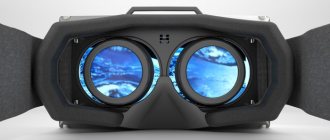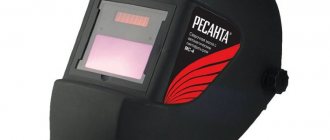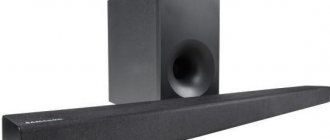The world of virtual reality is a relatively new entertainment that allows you to realize your wildest fantasies: go on a space journey, dive into the depths of the sea or fight hordes of zombies without leaving the couch.
To do this, you need very little - get VR glasses or a helmet. Manufacturers offer dozens of models with different characteristics. Taking into account the fact that this pleasure is not cheap, there is no room for error - you need to purchase a device with a high-quality picture, a minimum of shortcomings and support for advanced programs.
We figure out what to look for when choosing virtual reality glasses and helmets, and talk about the TOP models that 100% will not disappoint.
VR glasses and helmets – types and features
There are so many virtual reality devices that it’s easy to get confused in a series of models and technical characteristics - manufacturers never tire of delighting us with new developments and improvements to old gadgets. Conventionally, VR glasses and helmets can be divided into several groups:
- budget models of glasses made of cardboard (Cardboard) - an imitation of virtual reality that does not allow you to fully experience the world of VR; the only advantage is the price;
- middle price segment of glasses - the body is made of plastic, the design can be quite flimsy, but it is in this segment that the abundance of models is concentrated;
- advanced VR glasses – an expensive segment that works only with modern smartphone models, has advanced functionality and additional options;
- virtual reality helmets are not inferior to advanced glasses (often even superior to them in terms of characteristics), they work without a smartphone, but with a gaming PC or independently.
The most realistic immersion in virtual reality is provided by VR helmets, but they have a key drawback - high price, but such devices are comfortable to work with and even after a long game there are usually no side effects (dizziness, nausea).
What is virtual reality
You may be under the impression that virtual reality devices have been around for a few years, but that's not true. In recent years, there has been a surge of interest in this kind of gadgets due to significant progress in their production.
In fact, the first models of helmets and glasses appeared in the late 70s of the last century. At the same time, the concept of “virtual reality” was introduced as an artificial world created using technical means, with which a person can interact through sensations.
What are VR glasses for?
Modern VR glasses for smartphones, as well as the very first prototypes, are necessary in order to create the illusion of a three-dimensional image.
TOP 5 best models of virtual reality glasses
The era of the future has arrived today – and virtual reality devices fully confirm this. A good way to conquer the VR world are glasses for smartphones and computers (the latter are equipped with their own screen and connect to a PC, similar to helmets). We are talking about the best models of virtual reality glasses - with a reasonable price-quality ratio, advanced characteristics and a minimal set of jambs:
- Xiaomi Mi VR 2 is a model for phones with a display up to 5.7 inches, has a motion sensor, and a built-in Bluetooth remote control. There is hardware acceleration and focal length adjustment, the viewing angle is more than 100 degrees. The price is affordable - about 5,000 rubles, the disadvantages include the lack of Russification of the menu and the inability to play music.
- The BOBOVR Z6 is another affordable smartphone device that connects via Bluetooth. The glasses are compact, have good build quality, viewing angle – 110 degrees, price – a little more than 3,000 rubles. The downside is that lenses have an insufficient focus area and a small diopter depth; there are also frankly defective options (don’t forget to keep your receipt for exchange under warranty).
- Epson Moverio BT-300 is a rather unusual pair of glasses that work without a smartphone. The features of the model include good image resolution, an abundance of sensors and a remote control with GPS. Well suited for watching online video from drones. There are some downsides - the manufacturer uses outdated software, the battery is frankly weak, and the price tag exceeds 70,000 rubles.
- Samsung Gear VR – glasses from a renowned manufacturer, equipped with a controller and many sensors. The model has easy controllability, it can be connected to a PC, and the build quality is good. However, users complain about the paucity of content in the game library and the not very clear picture even at high resolution. Price – about 20,000 rubles.
- HOMIDO Grab is an extremely budget-friendly pair of glasses that largely replicate the functionality of Cardboard, are focused more on watching videos than playing games, work with a phone, and are easy to set up. The key plus is the price tag in the range of 1-1.5 thousand rubles. and good assembly, you can give it to a child without fear of breaking it.
The rating of virtual reality glasses is based on user reviews and characteristics. However, comparing budget models and expensive devices is not very correct - in terms of quality of work, the first option, of course, will lose, so when choosing, be guided by your own goals and budget.
Category of the best virtual reality glasses (helmets) for phones: price – quality
When the issue of cost is quite acute, you have to choose a product that will have a fixed price and meet the optimal parameters. Let's look at the rating of devices in which manufacturing brands managed to obtain the maximum price-quality balance.
FIBRUM PRO
The lightest glasses (weight 120 g)
Average cost: 6490 rub.
Rating (2017): 4.5
The Fibrum Pro product is the lightest of the “advanced” glasses category. They weigh 120 g. When compared with a connected smartphone, this helmet weighs 2 times less, unlike Gear VR without a connected smartphone! Fibrum Pro also became a leader in “immersion depth”. It uses a viewing angle of 110 degrees (Samsung has 101 degrees, HOMIDO has 100 degrees). This nuance is especially felt when watching films.
Buy
Advantages and disadvantages:
- Russian production. The glasses were developed by specialists from St. Petersburg and Moscow. Production facilities are located in China.
- In addition to its light weight, the gadget is distinguished by its compactness. Its width is a quarter smaller than that of the Gear VR product (Fibrum 145 mm, Gear VR 208 mm).
- There are many more disadvantages. Quite a flimsy design. The smartphone is secured with four latches, which look unreliable.
- The product does not have the ability to connect peripherals, and they can compete with Samsung only on cost. In terms of available functionality, they compete with Xiaomi Mi VR products.
HOMIDO V1
The best VR glasses for the whole family
Average cost: 4990 rub.
Country: France, but made in China.
The distance between the eyes is different for each person. The main disadvantage of virtual reality glasses is that they cannot be adjusted. Having an incorrect pupillary distance can lead to headaches and eye strain. Vision deterioration will occur in the long term. The developers of HOMIDO V1 were able to solve this problem. Nowadays such glasses are equipped with the most flexible system for adjusting the optics. This means that the device is ideal for use with multiple users, for example if the glasses are purchased for family use.
Buy
Model features:
- Small dimensions, and the depth indicator is only 93 mm (Samsung Gear VR has 123 mm). Weight – 195 g (Samsung – 345 g).
- Universal parameters for any smartphone. The device is compatible with iPhone/Android. You can use a smartphone with a display of 4 inches or more with the gadget.
- The distance between the lenses can be adjusted, as well as the focal length.
- There are also many disadvantages. The product does not have a charging interface, motion sensors, accelerometer or gyroscope.
SAMSUNG GEAR VR (SM-R323)
Availability of touch control panel. Best functionality
Average cost: 7248 rub.
Country: South Korea, but produced in Vietnam.
The Samsung Gear VR product is not the cheapest glasses. For the stated price, they offer not only a stylish design, but also a set of capabilities that have not previously been implemented in virtual reality helmets. Navigation in the helmet is carried out using the built-in touchpad. The phone can be fully used because of the Home button and physical keys for volume control. The helmet is ideal for users who cannot use a full helmet due to vision problems.
Buy
Advantages and disadvantages:
- The device body is equipped with a ventilation system. This is done to prevent the lenses from fogging up when worn for a long time.
- Samsung developers took into account the shortcomings of the previous version of the device, so the VR (SM-R323) uses a soft type of seal to protect the skin from pressure. For fastening on the head there is a strap made of soft fabric.
- The glasses have a USB interface to connect a charger, for example, if there is not enough battery power when playing a movie.
- Possibility of diopter adjustment. The focal length of the lenses is manually adjusted, so the glasses can be used by people with good vision and those who have similar problems.
- The disadvantages are the Korean brand’s desire to market only its own products. The glasses are supported exclusively by Samsung gadgets S7/Edge7/Note 5+/S6/S6+/Edge6/6+.
TOP 7 VR helmets – comparison and review of the best
If virtual reality glasses are presented in both budget and expensive price ranges, the cost of VR helmets will traditionally be many times higher. Gadgets with a good picture can only be selected with a budget of at least 40,000 rubles, and for some models the cost has long exceeded 100 thousand rubles. The leaders in the rating of virtual reality helmets are:
- HTC Vive is a model that conquered the VR market back in 2021. Although several years have passed, the device remains the ultimate dream of many gamers. It has a built-in AMOLED display, the gadget works with any software, has laser head position sensors, and there are no problems with searching for content. Price – about 65,000 rubles.
- Valve Index is a helmet with two RGB LCD displays, high frame rates and fast display response time. The model is equipped with beveled lenses, thanks to which the viewing angle is 20° greater than that of the HTC Vive. The price of one helmet is 45,000 rubles, but for a better perception you will need a kit with a controller and base stations, which automatically raises the cost much higher than 100 thousand rubles.
- Pimax 8K X is a gadget for true connoisseurs who are willing to pay generously for visual pleasure. The helmet is equipped with two 4K displays, has an adjustable frame rate using Dual Engine Mode technology, and offers a unique viewing angle of 200°. The device supports almost 2,000 games and applications and has clear ergonomics. The price of a “naked” helmet is 150 thousand rubles, for a set with controllers and base stations you will have to pay over 230 thousand rubles.
- Oculus Go is a budget device with greatly reduced functionality and performance, which can be purchased for around 20,000 rubles. There is no need to connect the helmet to a PC or smartphone; it works as an independent device, the viewing angle is 100 degrees. The downside is that the battery is not very capacious, which lasts for a couple of hours of continuous play.
- Oculus Quest 2 is another budget device from Oculus. Prices start from 30 to 50 thousand rubles. A completely autonomous helmet with fairly powerful hardware. However, it is still inferior in quality to wired ones. The biggest disadvantage is its attachment to the Oculus ecosystem, where you will have to pay several thousand rubles for each game.
- Samsung HMD Odyssey is a serious helmet that connects to a gaming PC. Equipped with a motion controller and a bunch of sensors - you can adjust almost every parameter. The viewing angle is very good – 110 degrees. Price – 60,000 rubles.
- Sony PlayStation VR is a stylish model for the PS4 console. The screen resolution here is not too high, but the refresh rate of 120 Hz provides a clear picture compared to its competitors. The device also works with glasses (convenient for players with impaired vision). There is a lot of content, but connecting a PC or smartphone is not available.
- Oculus Rift S is a high-quality flagship helmet with advanced optics, an abundance of sensors and thoughtful ergonomics. The model works with a gaming PC (you need to connect it to powerful computers, only when the minimum requirements are met, the picture suffers), it comes with good headphones, users note its light weight, which ensures comfortable gaming. Price – from 45,000 rubles.
The palm of virtual reality helmets has been captured by devices from the Oculus brand; they are equipped with their own ecosystem, are presented in several versions, and are distinguished by high build quality. The price tag is appropriate.
Retrospective of virtual reality glasses and helmets
Much to the dismay of many, the VR industry is experiencing an alarming lull.
The first generation of consumer headsets didn't come with any compelling content or ports of existing AAA video games (Skyrim and Fallout 4 don't count), and VR arcades remain rare to this day. Of course, the process of adapting new technology takes time. Even the iPhone did not immediately conquer the whole world. According to Game Insight Innovation Director Andrey Ivashentsev, VR technologies are now at the stage of attracting the first adopters.
Gartner, new technology maturity cycle, 2017
Others are not so optimistic. Let's take the consulting company Gartner, which very accurately describes the current situation with its concept of the maturity cycle. Now VR headsets are at the stage of reaching a “productivity plateau”, and at best there are 2 to 5 years left before the technology is adopted by the masses.
In fact, the development cycle of VR headsets repeats itself. Even Palmer Luckey did not come up with anything new, but took old ideas and re-implemented them. Virtual reality will truly “take off” only if the experience of the past is taken into account and mistakes are corrected. It's time to get acquainted with this past.
Homo habilis virtual glasses: 19th century stereoscope
What is this:
The stereoscope, the very first “virtual reality headset,” was created by English physicist and inventor Sir Charles Wheatstone in 1838. The strange device demonstrated the importance of human binocular vision: two mirrors placed at an angle reflected two pictures so that the human observer saw a three-dimensional object. Then Scottish physicist Sir David Brewster improved the concept by eliminating the mirrors and replacing them with lenses. To operate, his stereoscope required a slide of a stereo pair - two images taken at a short distance from each other for the effect of volume.
Photography, suitable for creating such images, had just been invented in those same years. Brewster traveled to Paris, where he met photographic pioneer Jules Dubosc, who was the first to make stereo-daggerotypes and stereoscopes. The new “gadget” was presented to the general public at the World Exhibition of 1851, after which it gained incredible popularity (more than 1 million stereoscopes were sold in England alone in 1953).
How it ended:
Inexpensive and easy to use, the stereoscope was a technological breakthrough for its time. All the necessary technologies for it appeared on time, and there were no competing devices, so consumers had nothing to compare with. Simple stereoscopes still exist, but, most importantly, the basic principle of their operation is the basis of all virtual reality glasses and helmets. They even look similar, like humans, to their upright ancestors.
Stereoscope 2.0: View-Master
What is this:
In 1935, the American company Eastman Kodak launched the production of Kodachrome color film. Just four years later, Sawyer's, a small Oregon photography service, developed the View-Master color stereoscope, which has long become one of the most beloved and recognizable gadgets in the United States.
The stereoscope worked with special cardboard disks, into which 14 color slides were mounted, that is, seven stereo pairs. Since Sawyer's produced postcards with picturesque views and attractions, the same images were on the discs. During World War II, the US government ordered millions of special View-Master discs from the company, which would train military personnel to identify enemy ships and aircraft at gun range. The promotion became the most successful advertising that Sawyer's could dream of, so the glory of the device faded only in the 70s. After this, View-Master transformed into a typical toy. Gadgets under this brand are still produced, but we are no longer talking about stereoscopes, but VR headsets for smartphones.
In the 50s, the USSR got its own “Soviet View-Master” - Stereoscope-1, produced in Leningrad at the photographic accessories factory. It, like the subsequent improved models Stereoscope-2 and Stereoscope-3, worked with square-shaped cards. The more common model was the Salyut stereoscope and its modification Salyut-M.
How it ended:
A successful military order ensured the gadget wide recognition in the United States. A lot of content was produced for View-Master; after slides with beautiful views and outlines of enemy transport, Sawyer's began releasing discs with footage from TV series and films. The deal with Disney was especially successful, because children liked the color images of cartoon characters and photographs of Disneyland. An equally decisive role was played by the invariability of the format and size of the media. View-Master models changed, but the old discs still fit.
The first real VR gadgets: Sensorama and Telesphere Mask
What is this:
Back in 1935, science fiction writer Stanley Weinbaum described a virtual reality helmet in his story “Pygmalion’s Glasses.” A year later, the writer died of lung cancer and did not have time to see how the fruit of his imagination turned into reality with utmost precision. This was done by American filmmaker and inventor Morton Hellig, who built and patented the Sensorama virtual machine in 1962. She blew air at the viewer, sprayed perfume, showed a first-person recording on two separate screens, and the sound changed depending on how its virtual source moved.
The Sensorama would later become Hellig's most famous invention, but in 1960 he patented video glasses that did much the same thing. The Telesphere Mask gadget was equipped with miniature picture tubes for transmitting images, an audio system, and some kind of device for transmitting smell and the effect of wind.
Hellig's virtual reality required special films, and the inventor himself filmed five demo videos. Four of them were devoted to riding a motorcycle, go-kart, bicycle and flying a helicopter. In the fifth, invented for potential Hollywood investors, the viewer was entertained by a belly dance performed by a New York dancer.
How it ended:
The production of VR machines was very expensive, and filming suitable material for them was no less expensive. In addition, the equipment was fragile and required careful handling. One trial Sensorama device was installed on the territory of Universal Studios, and that was the end of the commercial success of early virtual reality. Hollywood bosses had no idea how to market this new type of entertainment. The pioneer of virtual reality came too early to a world that was not ready either technologically or morally.
The prototype of the futuristic Telesphere Mask helmet is still kept by the widow of the inventor, Marianne Helig.
"Sword of Damocles" by Sutherland
What is this:
Yes, in the 60s and 70s, the Western public was completely unprepared for an alternative reality (except for the one so colorfully described by Hunter Thompson). Therefore, many developments exclusively appeared and remained within the walls of institutes. The virtual/augmented reality helmet “Sword of Damocles” by the famous scientist Ivan Sutherland was no exception to the rule.
https://www.youtube.com/watch?v=ISJWZpFIAlQ
The menacing installation was only partly a helmet. A significant part of it was too bulky for a person’s head, and hung from the ceiling, which earned it its nickname. The system included a computer that generated a simple wireframe model.
Despite the lack of graphics, the device was able to track the position of the user's eyes and head. The Sword of Damocles was built in 1968 by Sutherland and his student Bob Sproul as a science project. They hardly saw any use for the dangerous colossus in real life, so it remained an interesting scientific artifact of the era.
Sutherland, among other things, should be thanked for his object-oriented approach to programming, developments in the field of graphic displays and computer graphics. The professor had his own vision of what we call virtual reality today: “The limit of display development will be a room in which a computer can control the existence of matter. A chair in such a room is quite suitable for sitting on. Handcuffs created in such a room will bind, and a bullet created in such a room will be fatal." Maybe it’s a good thing that he didn’t finish the Sword of Damocles to the end.
NASA VIEW VR helmet
What is this:
In addition to scientists from the Massachusetts Institute of Technology, the military, and, of course, NASA, were also working on displays for virtual or augmented reality. In 1985, the space agency demonstrated the VIEW VR helmet and DataGlove, touch-sensitive gloves for it.
The system was connected to a separate computer, after which the generated three-dimensional color image was transferred to the helmet, significantly superior to Sutherland’s earlier work. The helmet was equipped with liquid crystal displays with a viewing angle of 120 degrees in all directions, and tracked the movements of the user's head. The input device was either a “three-dimensional cursor” or gloves.
How it ended:
NASA's design looked very impressive, almost like Daft Punk's helmets. Despite this, it remained a prototype. According to Stefan Ellis, head of the spatial perception laboratory at the Ames Research Center, the technology of the 1980s was not “mature” enough. Early VR systems were characterized by helmets that were too heavy, computers that were too slow, sensory gloves that constantly failed, and users who suffered from headaches and motion sickness. As a result, work in this direction was resumed only 20 years later.
Helmet from The Lawnmower Man: Eyephone
What is this:
NASA was helped with the development of the virtual reality system by VPL Research, whose founder Jaron Lanier coined the term “virtual reality.”
Lanier worked at Atari, but lost his position after it split in two in 1984. The gifted programmer and musician focused on his own projects, one of which turned into a full-fledged company. Over the years, VPL has released the DataGlove sensor glove, the DataSuit sensor suit, the AudioSphere surround sound system, the Isaac virtual reality engine and programming language for it, and, most importantly, the EyePhone virtual reality glasses.
A total of three versions of EyePhone were released. The first had LEEP lenses, a viewing angle of 90 by 60 degrees, and the LCD display resolution was 184.7 x 138.6 pixels per eye. Starting from the second version, Fresnel lenses were used, the viewing angle increased to a little over 100 degrees, and the resolution eventually increased to 416 × 277 pixels. The first version weighed 2.4 kilograms, the second - 1.1 kilograms.
How it ended:
The first two Eyephone models cost $9,000 each, the third - already $49,000. Despite the very high price, they were really sold to the mass consumer. In 1992, Eyephone became one of the “stars” of the cult film “The Lawnmower Man”, forever entrenched in the mass consciousness as the correct image of virtual reality glasses. In 1999, VPL filed for bankruptcy and sold all of its patents to Sun Microsystems. Nevertheless, a spit into eternity was made.
RoboCop Helmet: Sega VR
What is this:
In 1991, the Japanese company Sega joined the virtual arms race and announced the development of the Sega VR headset for the Sega Genesis and Saturn consoles. The promising project heralded a whole new technological era for bored gamers and cost just $200. The helmet itself combined two separate 300 x 200 pixel LCD displays, built-in headphones for surround sound, and a well-designed head tracking system. The sensors updated the helmet's position 100 times per second, and the image on the displays changed accordingly.
The most notable feature of the ambitious '90s device was its design, which was largely inspired by the 1951 film The Day the Earth Stood Still, the legendary Star Trek series and, of course, Paul Verhoeven's RoboCop. Four games were released for the helmet, including one called "Matrix Snatcher" - six years before the release of "The Matrix".
How it ended:
The prototype was presented at the international electronics exhibition CES-1993, the presentation took place behind closed doors. Those who were able to try the new product were not particularly impressed, so the loud launch was followed by an ominous silence and oblivion. Sega representatives claimed that they abandoned the project due to concerns for the safety of players, especially children. According to rumors, 40% of testers simply could not use the helmet due to motion sickness. As a result, VR headsets were sent to Japanese arcades.
Red-black sunset of the era: Nintendo Virtual Boy
What is this:
The Japanese gaming giant Nintendo cannot ignore such a daring challenge from Sega as a virtual reality helmet. The answer was the Nintendo Virtual Boy headset, perhaps the strangest VR device since the Sword of Damocles.
The basis was the development of the Massachusetts company Reflection Technologies, the Private Eye headset, and the monochrome display they invented. Instead of a full-fledged matrix, it consisted of a line of 1x224 LEDs and oscillating mirrors, which formed an image with a mechanical sweep of 50.2 Hz. The cheapest red LEDs were chosen for the display, resulting in a resolution of 384 x 224 pixels per eye. The device was also equipped with a built-in speaker, and it worked either from the mains or from 6 AA batteries.
The main developer of the system, Gunpei Yokoi, initially planned to create a lightweight headset that attaches to the head. Alas, his vision could not be translated into reality. Nintendo's lawyers were afraid that the company would be sued if a child wearing such a helmet got into an accident on the road and pieces of the device stuck in his eyes. Due to the precautions taken, the helmet gained excess weight, and as a result it was placed on legs. The height of the legs was not adjustable, which did not add convenience to the system. I had to forget about tracking, portability and aesthetics.
The corporation was simultaneously preparing for the release of the Nintendo 64 console, the games for which the legendary game designer Shigeru Miyamoto worked tirelessly on. He also couldn’t work on the VR console, so developers from Intelligent Systems were responsible for games for the Virtual Boy. In addition, deadlines were tight, so less experienced programmers had to try to get something done. These games were Space Pinball, the revenge boxer simulator Teleroboxer, and Mario Tennis.
How it ended:
The system generated a lot of interest when it was officially introduced in November 1994. The public warmed to the Virtual Boy immediately, testing the first units at Shinoshikai (Nintendo Space World) that same month and at CES in January 1995. In Japan, sales of the console started in June 1995, in the United States in August, it cost $179.95. The American press cautiously called the device an evolution of the View-Master, without expressing any particular enthusiasm. In total, they managed to sell about 770,000 units, which was the biggest failure for Nintendo. The VirtualBoy fiasco dampened gaming companies' interest in virtual reality for a long time.
VR for MS-DOS: Forte VFX1
What is this:
Of course, experiments with VR glasses did not end with the resounding failure of the Virtual Boy. Sony, Siemens and many smaller companies continued to create their own projects throughout the second half of the 90s and into the first decade of the new century. All such developments remained either prototypes or niche entertainment - like the VFX1 helmet from the New York company Forte.
A distinctive feature of this device was the thoughtfulness that Nintendo's defunct brainchild lacked. Despite the hefty weight of 1.1 kilograms, the helmet was well balanced and did not feel heavy. Both lenses and the distance between them were adjusted to suit the person's eyes, the cushions and lining provided a comfortable fit, and the AKG stereo headphones provided high-quality surround sound. The “visor” of the helmet rose up so that there was no need to remove the entire unit, which is very convenient. To control the game, a Cyberpuck, a puck-shaped joystick, was provided.
The VFX1 was designed to work with a PC; it even came with a special ISA VIP card, which was inserted into the computer before directly connecting the device. The kit included drivers and compatible games. Yes, this helmet worked with such hits of the 90s as Doom, Quake, Heretic and Descent, not to mention excellent compatibility with flight simulators.
The resolution of the LCD displays themselves was 263x230 pixels, slightly less than the standard 320x240. The tiny viewing angle left much to be desired: 35.5 degrees horizontally and 26.4 degrees vertically. But the device perfectly recorded head turns in three axes thanks to the built-in gyroscope and earth’s magnetic field sensor. Playing Doom, it was quite possible to imagine yourself as a sort of space marine in a tight helmet, caught in a Martian hell.
How it ended:
The initial cost of the VFX1 helmet was about a thousand dollars. The huge amount was the first obstacle, and the second was the need to deal with settings, hardware and drivers. Despite the prevalence of DOS, not every user of those times was able to understand the command line. Alas, this real miracle of technology turned out to be too complex and expensive for the average gamer.
The promising Oculus Rift
What is this:
The next spiral in the history of VR headsets began in 2012, when an unknown startup Oculus VR launched a Kickstarter campaign to fund a new VR headset called the Rift. The wildly successful campaign raised $2.5 million.
The company's founder, 20-year-old Palmer Luckey, has been interested in technology since childhood and experimented with it. He collected various HMD devices and dreamed of a helmet in which, say, he could play the VR version of Chrono Trigger.
https://www.youtube.com/watch?v=635rd34gP_I
As a result, he got to the point where he made such a helmet himself. The Oculus Rift truly became a dream come true: the latest OLED displays, 1080 x 1020 pixels per eye resolution, 90 Hz refresh rate, 110 degree viewing angle, built-in headphones with 3D sound. Most importantly: the Constellation camera system, which helps track the position of the user’s head and Oculus Touch controllers (the helmet itself contained an accelerometer and gyroscope, the basis of the system). The development took four years of Lucky's life: the Oculus Rift was released in March 2021.
How it ended:
In March 2014, Facebook acquired the successful startup for $2 billion. Immediately after this, ZeniMax Media sued Oculus VR for allegedly stealing the technology. The jury returned a verdict that the young innovator violated a non-disclosure agreement and fined Oculus $500 million in favor of ZeniMax. In 2021, Lucky’s reputation suffered again, this time due to his support for the presidential campaign of Donald Trump, who eventually won the US elections. In 2021, he left Facebook and his creation along with it.
These events had a somewhat negative impact on the public's perception of the Oculus product. However, two factors created really serious problems: a) the need to purchase a powerful computer with a new video card for a fairly expensive helmet; b) a limited selection of entertainment content. The developers involved in the creation of the latter encountered difficulties in adapting existing genres and helmet limitations to the new format. With video, things are a little better, but few are willing to spend a thousand dollars on equipment for watching movies and pornography in 3D.
Google Cardboard and friends
What is this:
Google is the next big stop in VR advancements. In 2014, while the Rift was still in design hell, visitors to the Google I/O conference were given strange cardboard boxes.
It turned out that they are made up of angular-looking masks with a separate slot for a smartphone. By putting one on the face and pulling the magnet, a person was instantly transported to virtual reality according to Google.
Cardboard at that time seemed like the most logical step that could be taken. Smartphone displays are getting better by the day, as is the power of small processors. Even the gyroscope was in place. Mobile gaming was gaining momentum. All that was left was to add a couple of lenses and an app.
Many followed Google's example. Samsung, Xiaomi, Mattel, and dozens of small startups have unveiled their VR headsets for smartphones, hoping to ride the rising wave.
How it ended:
Most smartphones are not designed to be held up to your nose and, on top of that, to magnify the screen with a healthy lens. Because in this case, the illusion of a beautiful color display is broken in a very crude way: the thinnest lines between the pixels become visible.
The so-called mosquito net effect is perhaps not the most serious defect for long-suffering VR technology. Smartphones cannot handle serious games, as they are optimized for other purposes (but the change of generations and the emergence of devices like the iPhone X can improve the situation). By the way, the grid is also seen in the Rift, but in the case of more complex hardware there are ways to improve image quality. However, this occurs against the background of devices in which the boundaries between pixels are not visible.
As an educational tool, the headset has no equal. But there are so many entertainment tools now that it’s hard for a VR accessory to compete with them. Even initial delight is often replaced by indifference, which is why the device is sent to gather dust on the shelf.
Free HTC Vive
What is this:
The American Valve Corporation, creator of the games Half-Life, Dota 2 and the Steam platform, joined the new historical era of VR in 2015. Then it became known that the company announced that, together with the Taiwanese HTC Corporation, it was working on HTC Vive virtual reality glasses for PC.
The development was largely the same as the Oculus Rift. The final resolution, scan frequency, and viewing angle are completely identical. The display was most likely produced at the same Samsung plant, and the requirements for the computer even exceeded the immodest claims of Oculus.
The difference was in such an important detail as tracking. Instead of optical sensors, it was equipped with a Lighthouse system, consisting of “laser towers” with infrared LEDs. The principle is similar, the light serves as a guide for the helmet and controllers. As a result, the user can not only spin in place, but also take several steps across a space of 3.5 x 3.5 meters. For a home VR device, this difference was revolutionary, because technology had not previously allowed anything like this.
How it ended:
After the successful launch of the consumer version of HTC Vive in April 2016, good news began to appear less and less often. According to some reports, Valve's development sold much better than Oculus glasses, but already in August 2021, HTC began to think about getting rid of its VR division. In any case, in an attempt to win over consumers, both competitors have lowered the prices of their headsets and continue to develop new helmet models. There are still no games worthy of the Vive's powerful hardware.
Hidden Dragon: PlayStation VR
What is this:
Sony has been involved in virtual reality since at least the 90s and even sold Glasstron glasses at one time. In 2014, the company announced the Morpheus VR helmet project, its response to the challenges of the new millennium.
In 2015, it became known that the helmet would be called Playstation VR. In October of the following year, the gadget was launched at a price of $399 in the US and €399 in Europe.
In terms of characteristics, the glasses were somewhat inferior to their competitors from Valve and Oculus. The resolution of OLED displays is 960 x 1080 pixels per eye, the viewing angle is 100 degrees, but the refresh rate is higher - 120 Hz. The most important advantage in the eyes of consumers was the absence of the need to buy an expensive computer, which was replaced by the Playstation 4 console. The camera released for the PlayStation back in 2013 is responsible for tracking.
How it ended:
Of all three “main” VR headsets of the new millennium, it was the Playstation VR that achieved the greatest success. Sony has sold more than 1 million units, driven by price, ease of installation, and a large library of games. Having a large number of PlayStation users didn't hurt either.
The next generation of virtual reality: Pimax 8K
What is this:
Let's return to Kickstarter, where the “virtual wave” of the 21st century started. Since the days of Oculus, VR headsets for smartphones have appeared on the platform more than once. However, in the second half of September, Chinese startup Pimax launched a campaign for a full headset with ultra-high resolution 8K (3840 x 2160 per eye).
Such a gigantic number of pixels fit on the screens due to the fact that engineers from the Middle Kingdom changed their orientation. Vive, Oculus and Playstation VR have almost square displays. Pimax has horizontally elongated ones, resulting in an impressive panoramic view of 200 degrees, and the “mosquito net” disappears almost completely. It is noteworthy that instead of OLED, Pimax uses liquid crystal displays, which, according to the creators of the helmet, are produced using technology adapted for VR.
For tracking, Pimax uses Lighthouse technology, the same as in Vive, so with such a helmet on your head you can walk around the room and in virtual space at the same time.
How it ended:
It's too early to say whether the Pimax 8K will find a place in the history of virtual reality gadgets. Since the device is just getting ready for release, only a small number of outsiders have had time to try it out, including at the IFA 2021 electronics exhibition held in September. We ourselves are waiting for our test sample to take a closer look at it and then share our impressions.
Pimax's crowdfunding campaign managed to break Oculus Rift's record and raise $3.2 million. For a Chinese campaign that does not hide its roots, this is a very worthy result. There are still three days left before the end of the campaign, so everyone has the opportunity to order the first virtual reality headset with a giant resolution on the Kickstarter campaign page and be one of the first to receive it.
What do you think about the endless struggle of the VR industry for a place in the sun? Have we missed historically important retro VR glasses? Share your opinion in the comments.
How to choose virtual reality glasses or helmet?
When planning to purchase your first VR helmet or glasses, do not expect that you will be able to provide for all the nuances and simply choose the ideal model (each device has its own disadvantages, and much depends on the preferences of the individual user). We advise you not to dig deep into the world of terms and characteristics, but focus on a few simple criteria:
- Price is the main factor, since it is the cost that allows you to immediately understand what kind of model is in front of you. If you are very limited in funds, look for pseudo-VR glasses, but it is better, of course, to save up and buy a model that is not expensive, but of a higher quality.
- Body - look at the assembly and fastenings; ideally, you can try on the glasses before purchasing (you can make sure that they are comfortable, the straps do not squeeze your head).
- Lenses and screen settings - the higher the resolution and viewing angle, the clearer the picture. We also recommend choosing models with the ability to adjust the interpupillary distance and focus - the latter parameter is especially important for people with visual impairments.
- Functional content - in cheap models there will be nothing besides lenses (hence the imitation of virtual reality). Advanced glasses and helmets are equipped with sensors and controllers - the cooler the filling, the better the immersion effect.
- Application store - find out in advance where you will have to download games, applications, movies. It’s good if you have your own library, which includes many programs (paid or free). In this regard, large brands win – unlike in “underground China,” there are no problems finding games.
VR helmets and glasses are a godsend for active gamers and fans of cool movies, because where else can you get the feeling of being really present on the battlefield, on a roller coaster or on board a spaceship?
When choosing a device, we recommend that you take your time with the purchase if you have never encountered the world of virtual reality before. Rent a helmet or come to a VR club to play - you need a little practice to understand what exactly you want from the gadget. Taking into account your own requirements and personal experience, choosing a cool model will be much easier.
Criteria for selecting a suitable model
The computer or laptop must have good characteristics (preferably a gaming laptop). Basic principles:
- The quality of virtual reality immersion is determined by the correct characteristics of eyepiece resolution, refresh rate, viewing angle, image level and tracking accuracy.
- Before choosing a VR helmet 2021 for PC, it is useful to test the mounts and internal stock.
- For gamers, responsive controllers are critical.
- Mobility is provided by models with wireless modules, or you can buy cheap VR glasses for PC without base stations.
Also pay attention to the number of sensors offered by the manufacturer: the more there are, the more realistic the sensations.











